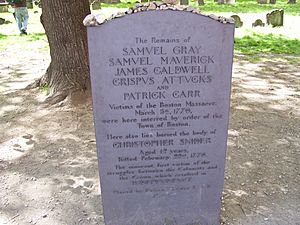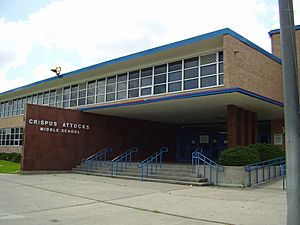Crispus Attucks facts for kids
Quick facts for kids
Crispus Attucks
|
|
|---|---|

Speculative 19th-century portrait of Crispus Attucks
|
|
| Born |
Crispus Attucks
c.1723 |
| Died | March 5, 1770 (age 47) |
| Occupation | Dockworker |
Crispus Attucks (c. 1723 – March 5, 1770) was an important figure in American history. He was a sailor and dockworker of African and Native American descent. Many people believe he was the first person killed in the Boston Massacre. This event helped start the American Revolution. Because of his death, Attucks became a symbol for freedom. He also became important for the abolitionist (anti-slavery) movement.
Attucks had a big impact on major historical events. Even today, over 250 years after his death, he is still remembered. Modern songs, stories, and TV shows talk about him. Some schools are named after him. In 2002, Attucks was named one of the "100 Greatest African Americans" in United States History.
Contents
Crispus Attucks' Early Life
Historians do not know much about Crispus Attucks' early life. His father, Prince Yonger, was born in Africa and was a slave. His mother, Nancy Attucks, was a Wampanoag Native American. One of Attucks' family members, John Attucks, was hanged during King Philip's War.
Attucks may have been born a slave in Framingham, Massachusetts. Some evidence suggests he escaped from slavery. In 1750, a slave-owner named William Brown put out an advertisement. He offered a reward for a runaway slave named Crispus. The description in the ad matched Crispus Attucks. This makes many people think he was a runaway slave. However, people still debate if he was a free man or an escaped slave.
Attucks worked as a sailor and spent much of his life at sea. He often worked on whalers, which meant long trips. Many historians believe he used the name "Michael Johnson." He might have done this to avoid being caught and sent back to slavery. In early 1770, he was likely in Boston only for a short time. He had just returned from a trip to the Bahamas. He was planning to leave soon for North Carolina.
The Boston Massacre and Its Impact

Crispus Attucks was killed during the Boston Massacre on March 5, 1770. This event happened when British soldiers fired into a crowd of colonists in Boston. Attucks and four other Americans died that day. Their deaths made the American people very angry. This anger helped to trigger the start of the American Revolution.
The five people killed in the Massacre were buried as heroes. Their graves are in the Granary Burying Ground. Important people like Samuel Adams and John Hancock are also buried there.
The British soldiers who fired their guns were put on trial. John Adams, who later became president, defended them. He argued that most soldiers fired in self-defense. Most of the soldiers were found not guilty of murder. Two soldiers were found guilty of a lesser crime called manslaughter. They were punished for their actions.
Why Crispus Attucks Is Important
After his death, Crispus Attucks became known as the first martyr of the American Revolution. A martyr is someone who dies for a cause. His death helped unite the American colonists against British rule.
Attucks also became a symbol for the abolitionist (anti-slavery) movement. In the early 1800s, this movement grew stronger in Boston. Supporters praised Attucks as an African American who played a heroic role in U.S. history. Because Attucks was of mixed African and Native American heritage, he also became an important figure in Native American history.
Honors and Legacy of Crispus Attucks
- 1858: People who wanted to end slavery, including William Cooper Nell, created "Crispus Attucks Day." This day honored Attucks.
- 1888: A large monument was built on Boston Common. It honors Attucks and the other victims of the Boston Massacre. The monument is over 25 feet tall. It shows the Boston Massacre with Attucks in the front. A female figure called Free America stands above the scene. She holds a broken chain and crushes the English crown. The names of the five men killed that day are carved into the monument.
- 1998: The U.S. Treasury released a special silver dollar coin. It featured Attucks' image. Money from the coin sales was meant for a Black Revolutionary War Patriots Memorial in Washington, D.C..
- 2002: Scholar Molefi Kete Asante listed Crispus Attucks as one of the 100 Greatest African Americans.
- Many places are named after Attucks. These include schools like Crispus Attucks High School in Indianapolis, Indiana, and Attucks Middle School in Houston, Texas. There are also theaters, associations, parks, and even a bridge named in his honor.
Crispus Attucks in Popular Culture
Crispus Attucks is remembered in many songs, poems, and books:
- Stevie Wonder mentions Attucks in his song "Black Man" with the line: "First man to die for the flag we now hold high was a black man."
- The rapper Nas mentions him in his song "You Can't Stop Us Now": "Crispus Attucks, the first blasted."
- Poet John Boyle O'Reilly wrote a poem when the monument was unveiled. It includes the lines: "And to honor Crispus Attucks who was the leader and voice that day: The first to defy, and the first to die, with Maverick, Carr, and Gray."
- Martin Luther King, Jr. spoke about Attucks in his book Why We Can't Wait (1964). He used Attucks as an example of moral courage.
- James Neyland wrote about Attucks' importance in a book. He said Attucks was important not just for African Americans, but for all people who have faced unfair treatment.
See also
 In Spanish: Crispus Attucks para niños
In Spanish: Crispus Attucks para niños


